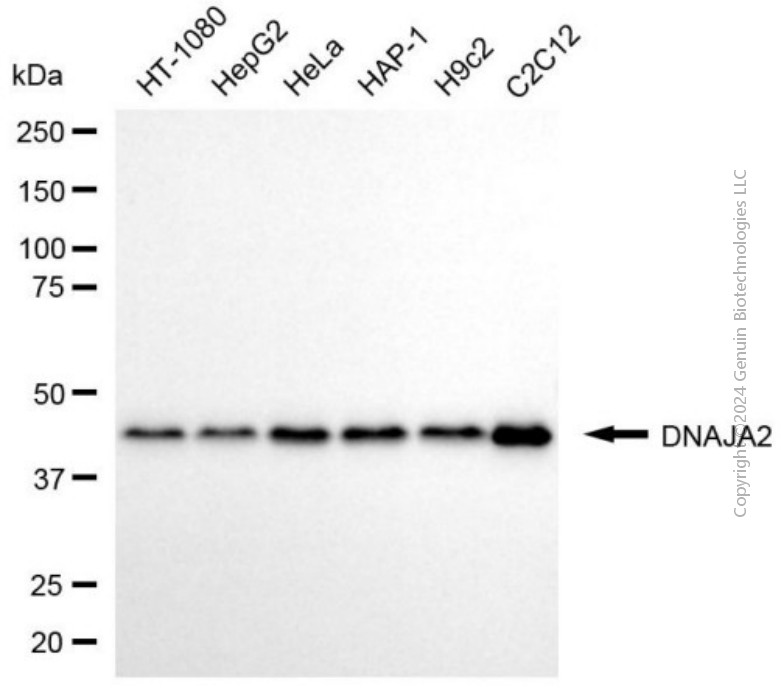KD-Validated Anti-DNAJA2 Mouse Monoclonal Antibody
Mouse monoclonal antibody
- SPECIFICATION
- CITATIONS
- PROTOCOLS
- BACKGROUND

Application
| WB, FC |
|---|---|
| Primary Accession | O60884 |
| Reactivity | Rat, Human, Mouse |
| Clonality | Monoclonal |
| Isotype | Mouse IgG1 |
| Clone Names | 24GB8120 |
| Calculated MW | Predicted, 46 kDa, observed, 46 kDa |
| Gene Name | DNAJA2 |
| Aliases | DNAJA2; DnaJ Heat Shock Protein Family (Hsp40) Member A2; HIRIP4; CPR3; DNAJ; DNJ3; Cell Cycle Progression Restoration Gene 3 Protein; DnaJ (Hsp40) Homolog, Subfamily A, Member 2; DnaJ Homolog Subfamily A Member; Renal Carcinoma Antigen NY-REN-14; Cell Cycle Progression 3 Protein; HIRA Interacting Protein 4; HIRA-Interacting Protein 4; PRO3015; DJA2; RDJ2; Dnj3; DJ3; Dj3 |
| Immunogen | Recombinant protein of human DNAJA2 |
| Gene ID | 10294 |
|---|---|
| Other Names | DnaJ homolog subfamily A member 2, Cell cycle progression restoration gene 3 protein, Dnj3, Dj3, HIRA-interacting protein 4, Renal carcinoma antigen NY-REN-14, DNAJA2, CPR3, HIRIP4 |
| Name | DNAJA2 |
|---|---|
| Synonyms | CPR3, HIRIP4 |
| Function | Co-chaperone of Hsc70. Stimulates ATP hydrolysis and the folding of unfolded proteins mediated by HSPA1A/B (in vitro) (PubMed:24318877). |
| Cellular Location | Membrane; Lipid-anchor |

Thousands of laboratories across the world have published research that depended on the performance of antibodies from Abcepta to advance their research. Check out links to articles that cite our products in major peer-reviewed journals, organized by research category.
info@abcepta.com, and receive a free "I Love Antibodies" mug.
Provided below are standard protocols that you may find useful for product applications.
If you have used an Abcepta product and would like to share how it has performed, please click on the "Submit Review" button and provide the requested information. Our staff will examine and post your review and contact you if needed.
If you have any additional inquiries please email technical services at tech@abcepta.com.














 Foundational characteristics of cancer include proliferation, angiogenesis, migration, evasion of apoptosis, and cellular immortality. Find key markers for these cellular processes and antibodies to detect them.
Foundational characteristics of cancer include proliferation, angiogenesis, migration, evasion of apoptosis, and cellular immortality. Find key markers for these cellular processes and antibodies to detect them. The SUMOplot™ Analysis Program predicts and scores sumoylation sites in your protein. SUMOylation is a post-translational modification involved in various cellular processes, such as nuclear-cytosolic transport, transcriptional regulation, apoptosis, protein stability, response to stress, and progression through the cell cycle.
The SUMOplot™ Analysis Program predicts and scores sumoylation sites in your protein. SUMOylation is a post-translational modification involved in various cellular processes, such as nuclear-cytosolic transport, transcriptional regulation, apoptosis, protein stability, response to stress, and progression through the cell cycle. The Autophagy Receptor Motif Plotter predicts and scores autophagy receptor binding sites in your protein. Identifying proteins connected to this pathway is critical to understanding the role of autophagy in physiological as well as pathological processes such as development, differentiation, neurodegenerative diseases, stress, infection, and cancer.
The Autophagy Receptor Motif Plotter predicts and scores autophagy receptor binding sites in your protein. Identifying proteins connected to this pathway is critical to understanding the role of autophagy in physiological as well as pathological processes such as development, differentiation, neurodegenerative diseases, stress, infection, and cancer.




